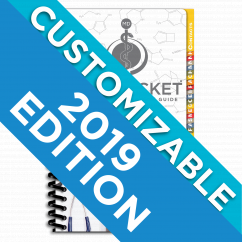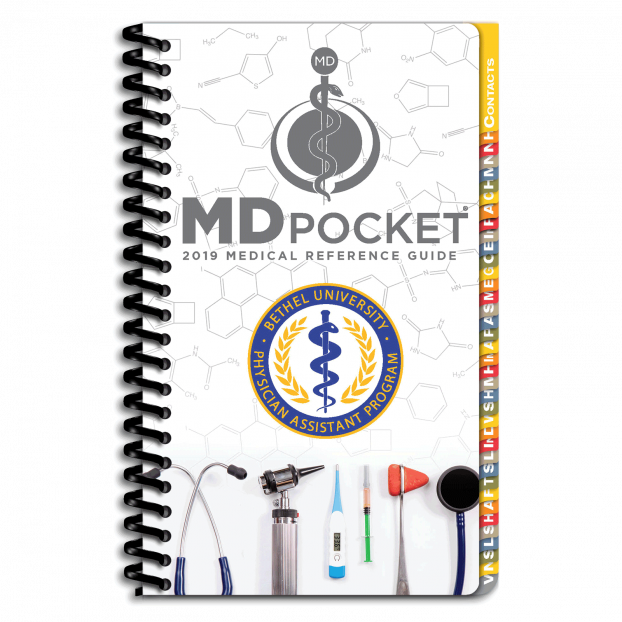- Home
- Reference Guides
- Physician Assistants
- MDpocket Bethel University - St. Paul Campus - Physician Assistant Edition - 2019

MDpocket Bethel St. Paul PA - 2019
2019 Updates
-
Hypertension guidelines – 1 page added to the 2019 Hypertension chapter (now a 2 page layout) to define the new blood pressure measurements and classifications. This additional page adds patient specific considerations when selecting blood pressure medications. Recent hypertension guidelines were changed in 2017 as defined by evidence based guidelines and can be found at: Guideline for the Prevention, Detection, Evaluation, and Management of High Blood Pressure in Adults, Journal of the American College of Cardiology (2017), doi: 10.1016/j.jacc.2017.11.006.
-
Microbiology chart and antibiotic spectrums – 2019 updated current antibiotic coverage based on the most accurate information to improve the changing spectrum of drug coverage. New antibiotic chart demonstrates spectrum of coverage from ++ to - and improves the original design with guidelines established by Sanford and package inserts.
-
CHA2DS2-VASc – updated to the January 2019 Atrial Fibrillation (AF) thromboembolic risk assessment, classification and treatment guidelines. This update focuses on the CHADS-VASc risk assessment with guideline changes from 2014 on patient populations to treat with anticoagulation. AHA/ACC/HRS Focused Update of the 2014 AHA/ACC/HRS Guideline for the Management of Patients With Atrial Fibrillation: a report of the American College of Cardiology/American Heart Association Task Force on Clinical Practice Guidelines and the Heart Rhythm Society. Circulation. 2019;13
-
Nausea, Vomiting, Diarrhea, and Constipation Medications – 1 additional page added to this update and now includes current medications and doses for opioid induced constipation (OIC), chronic idiopathic constipation (CIC), irritable bowel syndrome - constipation (IBS-C). Nausea and vomiting medications were organized and brand names added for completeness.
-
Anticoagulation (New addition to 2019 reference) – Added newest novel anticoagulation medications approved - Edoxaban and Betrixaban to the rapidly growing list of anticoagulants. Rearrangement of the table was done to provide more information for the user on dosing, uses, precautions, drug interactions, and monitoring.
-
Immunizations 2019
Latest immunization guidelines from Advisory Committee on Immunization Practices (ACIP) for 2019 that include infant, child, adolescent, adult, and high risk groups.
Changes to 2018 version:-
Adult Schedule
- LAIV has been listed separately from inactivated influenza vaccine (IIV) on the immunization schedule and is an option for adult through age 49 (excluding those listed).
- Heplisav-B was add to the 2019 schedule as an option routinely administered in 2 doses given at least 4 weeks apart. It can be used as a substitute in a 3-dose series with a different hepatitis B vaccine, but a valid 2-dose series requires 2 doses of Heplisav-B with at least 4 weeks between doses.
-
Additional language add to table for precautions, delay and contraindications:
- Precaution – vaccine might be indicated if benefit of protection outweighs risk of adverse reaction is highlighted in orange
- Delay in vaccination – vaccine that should not be given to pregnant women is highlighted in pink
- Contraindicated or use not recommended – vaccine should not be administered because of risk factors for serious adverse reaction is highlighted in red.
-
Child and Adolescent Schedule
-
LAIV has been listed separately from inactivated influenza vaccine (IIV) on the immunization schedule and is an option for adult through age 49 (excluding those listed).
-
Heplisav-B was add to the 2019 schedule as an option routinely administered in 2 doses given at least 4 weeks apart. It can be used as a substitute in a 3-dose series with a different hepatitis B vaccine, but a valid 2-dose series requires 2 doses of Heplisav-B with at least 4 weeks between doses.
-
Additional language add to table for precautions, delay and contraindications:
-
Precaution – vaccine might be indicated if benefit of protection outweighs risk of adverse reaction is highlighted in orange
-
Delay in vaccination – vaccine that should not be given to pregnant women is highlighted in pink
-
Contraindicated or use not recommended – vaccine should not be administered because of risk factors for serious adverse reaction is highlighted in red.
-
-
LAIV has been listed separately from inactivated influenza vaccine (IIV) on the immunization schedule.
-
Precaution added to Meningococcal B vaccine for pregnancy.
-
Tdap updated to with catch-up vaccination and use in pregnant adolescents.
-
-

Customize this book:
Use our book customizer to create the perfect book for you! Add extra chapters, change chapter order and remove chapters you don't need. Try it out by clicking the "Customize this book" button above or click here to see more information.

Make this book a binder:
While a spiral coil comes standard, your book can be bound in a 6-hole binder for added durability. We offer a lightweight but heavy-duty aluminum binder.

Add extra notes pages:
A handy available option for prolific notes-takers are extra blank notes pages! You can add as many as you want to the back of your book so you'll always have paper on hand.

Add a pocket page:
If you need a little extra room to store paper or cards, add a pocket page to your book. Placed after the notes pages in your book (and even lined to be used like a notes page) our pocket pages will hold any paper smaller than the book for safe keeping.

978-1-943991-40-2 978-1-943991-40-2 30.95
This is your custom book price
Price in reward points: 3095
MDpocket Bethel St. Paul PA - 2019
2019 Updates
-
Hypertension guidelines – 1 page added to the 2019 Hypertension chapter (now a 2 page layout) to define the new blood pressure measurements and classifications. This additional page adds patient specific considerations when selecting blood pressure medications. Recent hypertension guidelines were changed in 2017 as defined by evidence based guidelines and can be found at: Guideline for the Prevention, Detection, Evaluation, and Management of High Blood Pressure in Adults, Journal of the American College of Cardiology (2017), doi: 10.1016/j.jacc.2017.11.006.
-
Microbiology chart and antibiotic spectrums – 2019 updated current antibiotic coverage based on the most accurate information to improve the changing spectrum of drug coverage. New antibiotic chart demonstrates spectrum of coverage from ++ to - and improves the original design with guidelines established by Sanford and package inserts.
-
CHA2DS2-VASc – updated to the January 2019 Atrial Fibrillation (AF) thromboembolic risk assessment, classification and treatment guidelines. This update focuses on the CHADS-VASc risk assessment with guideline changes from 2014 on patient populations to treat with anticoagulation. AHA/ACC/HRS Focused Update of the 2014 AHA/ACC/HRS Guideline for the Management of Patients With Atrial Fibrillation: a report of the American College of Cardiology/American Heart Association Task Force on Clinical Practice Guidelines and the Heart Rhythm Society. Circulation. 2019;13
-
Nausea, Vomiting, Diarrhea, and Constipation Medications – 1 additional page added to this update and now includes current medications and doses for opioid induced constipation (OIC), chronic idiopathic constipation (CIC), irritable bowel syndrome - constipation (IBS-C). Nausea and vomiting medications were organized and brand names added for completeness.
-
Anticoagulation (New addition to 2019 reference) – Added newest novel anticoagulation medications approved - Edoxaban and Betrixaban to the rapidly growing list of anticoagulants. Rearrangement of the table was done to provide more information for the user on dosing, uses, precautions, drug interactions, and monitoring.
-
Immunizations 2019
Latest immunization guidelines from Advisory Committee on Immunization Practices (ACIP) for 2019 that include infant, child, adolescent, adult, and high risk groups.
Changes to 2018 version:-
Adult Schedule
- LAIV has been listed separately from inactivated influenza vaccine (IIV) on the immunization schedule and is an option for adult through age 49 (excluding those listed).
- Heplisav-B was add to the 2019 schedule as an option routinely administered in 2 doses given at least 4 weeks apart. It can be used as a substitute in a 3-dose series with a different hepatitis B vaccine, but a valid 2-dose series requires 2 doses of Heplisav-B with at least 4 weeks between doses.
-
Additional language add to table for precautions, delay and contraindications:
- Precaution – vaccine might be indicated if benefit of protection outweighs risk of adverse reaction is highlighted in orange
- Delay in vaccination – vaccine that should not be given to pregnant women is highlighted in pink
- Contraindicated or use not recommended – vaccine should not be administered because of risk factors for serious adverse reaction is highlighted in red.
-
Child and Adolescent Schedule
-
LAIV has been listed separately from inactivated influenza vaccine (IIV) on the immunization schedule and is an option for adult through age 49 (excluding those listed).
-
Heplisav-B was add to the 2019 schedule as an option routinely administered in 2 doses given at least 4 weeks apart. It can be used as a substitute in a 3-dose series with a different hepatitis B vaccine, but a valid 2-dose series requires 2 doses of Heplisav-B with at least 4 weeks between doses.
-
Additional language add to table for precautions, delay and contraindications:
-
Precaution – vaccine might be indicated if benefit of protection outweighs risk of adverse reaction is highlighted in orange
-
Delay in vaccination – vaccine that should not be given to pregnant women is highlighted in pink
-
Contraindicated or use not recommended – vaccine should not be administered because of risk factors for serious adverse reaction is highlighted in red.
-
-
LAIV has been listed separately from inactivated influenza vaccine (IIV) on the immunization schedule.
-
Precaution added to Meningococcal B vaccine for pregnancy.
-
Tdap updated to with catch-up vaccination and use in pregnant adolescents.
-
-

Customize this book:
Use our book customizer to create the perfect book for you! Add extra chapters, change chapter order and remove chapters you don't need. Try it out by clicking the "Customize this book" button above or click here to see more information.

Make this book a binder:
While a spiral coil comes standard, your book can be bound in a 6-hole binder for added durability. We offer a lightweight but heavy-duty aluminum binder.

Add extra notes pages:
A handy available option for prolific notes-takers are extra blank notes pages! You can add as many as you want to the back of your book so you'll always have paper on hand.

Add a pocket page:
If you need a little extra room to store paper or cards, add a pocket page to your book. Placed after the notes pages in your book (and even lined to be used like a notes page) our pocket pages will hold any paper smaller than the book for safe keeping.


